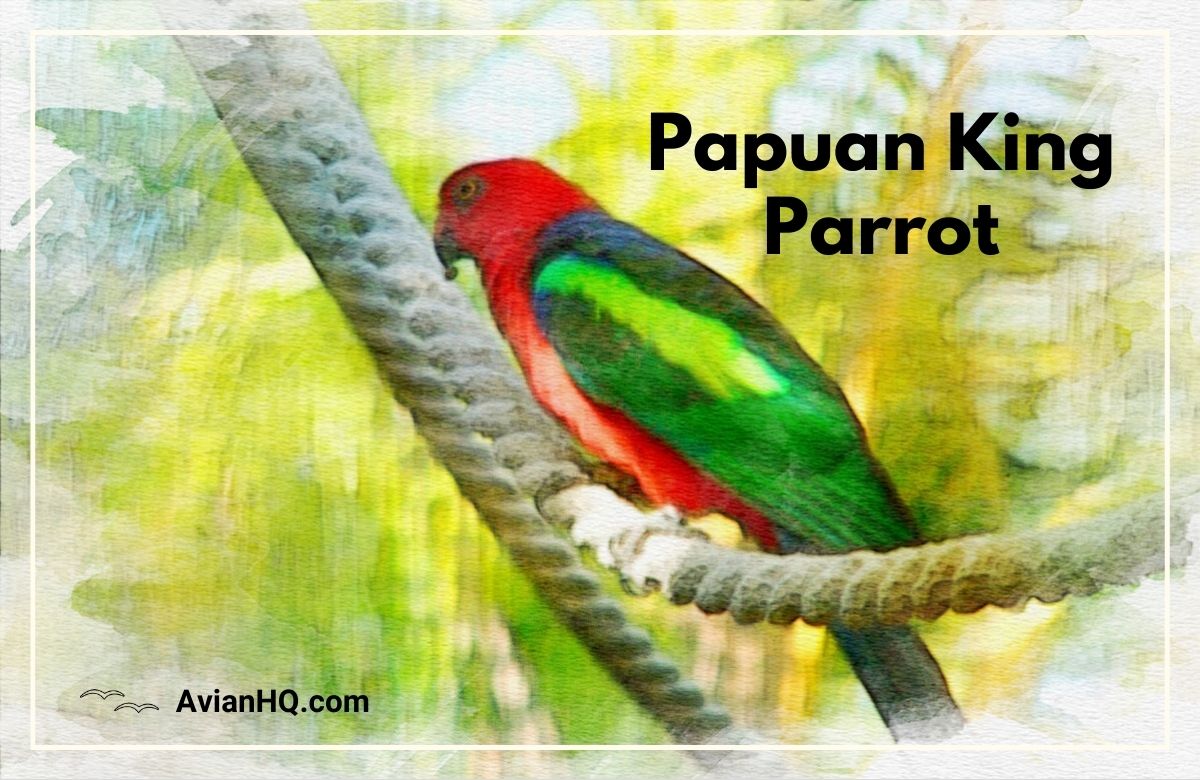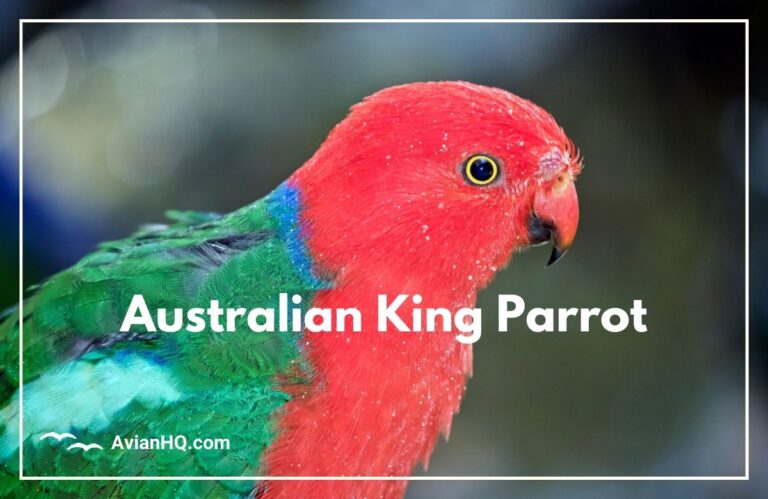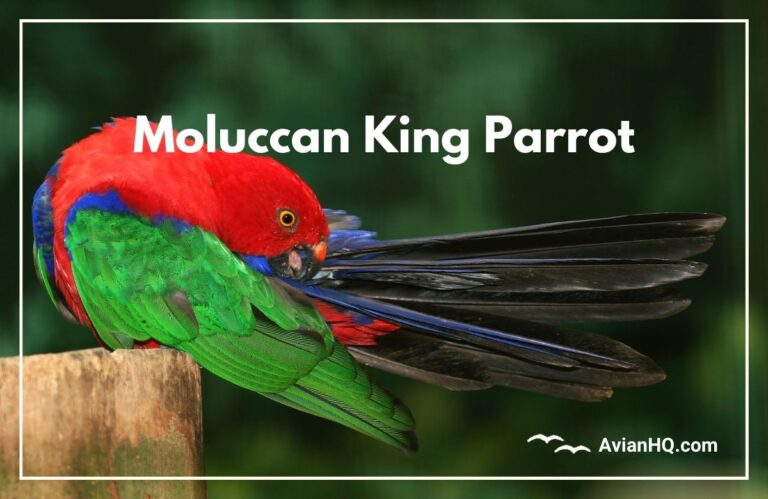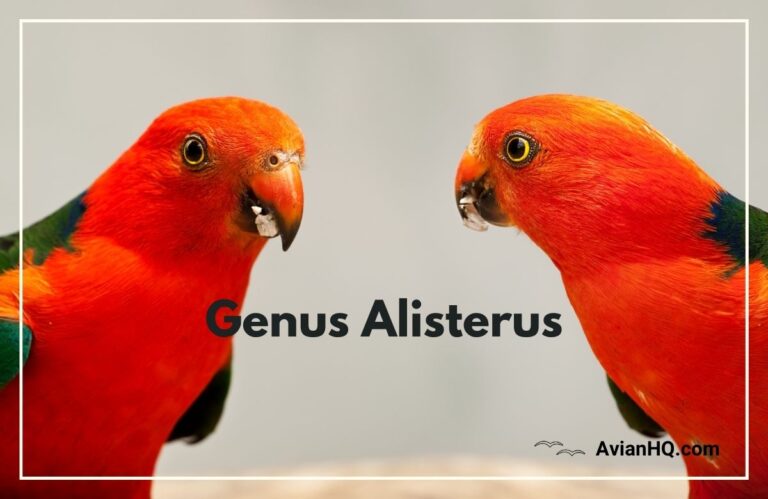Papuan King Parrot (Alisterus chloropterus)
The Papuan King Parrot is truly royalty among the parrots of New Guinea. With it’s bright red, green, and blue plumage, this bird is a jewel of the rainforest canopy. Though rarely seen due to it’s quiet nature, the Papuan King Parrot is a treasure for any birder lucky enough to catch a glimpse.
Getting acquainted with this majestic parrot offers insight into New Guinea’s spectacular biodiversity. We’ll cover everything from it’s taxonomy and physical appearance to it’s habitat, diet, and conservation status. Whether you’re an ornithologist, a bird enthusiast, or simply curious, you’ll learn fascinating facts about this little-known tropical species.
History and Taxonomy of the Papuan King Parrot
The vibrant Papuan King Parrot was first described scientifically in 1879 by Australian ornithologist Edward Pierson Ramsay. He named the species Aprosmictus chloropterus, classifying it in the genus Aprosmictus.
In 1912, British zoologist Walter Rothschild moved this species to it’s current genus Alisterus, based on differences from other king parrots. The name Alisterus chloropterus became officially accepted.
The genus name Alisterus likely references Alexander the Great, hinting at a regal stature. The species name chloropterus derives from the Ancient Greek words chlōros meaning “green” and pteron meaning “wing.” This describes the distinctive green wing patches.
Three subspecies are recognized today based on geographic ranges and minor plumage variations:
- A. c. chloropterus (nominate) – Eastern New Guinea
- A. c. callopterus – Central highlands and west
- A. c. moszkowskii – Northern coastal regions
The chloropterus subspecies was the first described from eastern New Guinea. In 1879, Italian naturalist Luigi D’Albertis collected the callopterus subspecies in the central mountains and named it in 1880 along with ornithologist Tommaso Salvadori. Lastly, the moszkowskii subspecies was named in 1911 by German ornithologist Anton Reichenow based on northern specimens.
Further taxonomic revisions may occur as more genetic analysis and field observations build our understanding of this species’ diversity across it’s range. But for now, the Papuan King Parrot remains classified as the single species Alisterus chloropterus with three distinct subspecies.
Physical Appearance and Identification
The Papuan King Parrot is a striking medium-sized parrot reaching about 14 inches (36 cm) long including it’s long tail. It weighs between 4.8-6.6 ounces (138-190 grams). The three subspecies vary slightly in their plumage details.
Main Identifying Features
- Size – Total length around 14 inches with a long tail making up half of that. Weighs under 7 ounces.
- Wings – Bright green with vivid yellow-green wing patches on males. Females have darker green wings lacking wing patches.
- Plumage – Males have vivid red head and underparts, blue back/rump, and black/green wings. Females are mostly green with some red underparts.
- Bill – Orange/red tipped with black.
- Eyes – Orange irises.
- Legs – Grey legs and feet.
Male vs Female Plumage
- Males are brightly colored with red head and underparts, blue back band, and conspicuous green wing patches.
- Females are predominantly green above with red restricted to underparts. They lack the male’s contrasting colors and wing patches.
Juvenile Plumage
- Immature males resemble adult females until acquiring mature plumage around 4 years old.
- Juvenile females have little to no red, darker bill, and dark brown eyes that lighten to orange as they mature.
Subspecies Differences
- A. c. chloropterus – Nominate race with most extensive blue on back.
- A. c. callopterus – Blue band on mantle narrower and restricted.
- A. c. moszkowskii – Least blue on mantle. Females resemble males in plumage.
The Papuan King Parrot’s regal plumage makes it a jewel of New Guinea’s forests. It’s vibrant colors likely serve social signaling functions and camouflage the parrots within the rainforest canopy.
Habitat and Distribution of the Papuan King Parrot
The Papuan King Parrot is endemic to the island of New Guinea, inhabiting dense tropical rainforests across much of the island. It’s elevational range extends from sea level up to about 8,500 feet (2,600 meters).
Within this forest habitat, the parrots prefer areas with tall, mature trees. This includes both primary rainforest as well as older secondary forest. The three subspecies each have their own home range:
- A. c. chloropterus in forests of eastern New Guinea
- A. c. callopterus in the central highland forests
- A. c. moszkowskii in northern coastal and island forests
Though widespread, the Papuan King Parrot occurs in low densities. It is described as “uncommon” or “rare” throughout it’s range. However, it can be locally common in some areas. The global population has not been quantified but is estimated to number around 70,000 individuals.
Outside of New Guinea, the Papuan King Parrot has not been introduced to any other regions. Within New Guinea, deforestation is reducing it’s preferred mature forest habitat. However, it’s elevational range provides some buffer against habitat loss. Ongoing conservation efforts aim to protect sections of rainforest across the island.
Diet and Feeding Habits
Like many parrots, the Papuan King Parrot is omnivorous, consuming a variety of plant and animal material. It’s main diet consists of fruits, seeds, nuts, and berries. Documented food items include:
- Fruits: figs, berries, citrus fruits
- Seeds and nuts: acacia, casuarina, eucalyptus, hazelnuts
- Flowers and nectar
- Some insects and grubs
The parrots often use their strong curved beaks to crack hard nuts and seeds. They employ their zygodactyl toes (two forward, two back) for gripping and climbing through branches. Sometimes they hang upside down to reach food sources.
Small flocks forage together, feeding calmly and deliberately. Their bright plumage provides camouflage in the rainforest canopy. Papuan King Parrots usually blend in quietly, going unnoticed even by observant birders.
Breeding and Reproduction of the Papuan King Parrot
The breeding habits of the Papuan King Parrot are not extensively studied, but some key details are known. The breeding season begins around March. The parrots nest in tree cavities, either natural hollows or old woodpecker holes.
Clutch size is typically 3-4 eggs. The female incubates the eggs for about 21 days before they hatch. Once hatched, the chicks are altricial, meaning they are helpless and require extensive parental care.
Both parents share duties feeding the chicks regurgitated food in the nest. After around 8 weeks, the young fledge and leave the nest. However, the parents continue to care for them for some time after fledging. From hatching to independence is about 11-12 weeks total.
Based on studies of related parrots, researchers estimate the Papuan King Parrot’s lifespan in the wild at 15-25 years. In captivity, with proper care, individuals may live over 25 years. Longevity likely depends on factors like predation, disease, and habitat quality in the wild.
The parrots reach sexual maturity and begin breeding around 3-5 years old. The breeding pairs engage in courtship rituals like preening each other’s feathers and feeding close together. Not much else is known about their reproductive behavior, providing opportunities for future research.
Behavior and Ecology of the Papuan King Parrot
The Papuan King Parrot exhibits behavior typical of forest-dwelling parrots. They live in small flocks, usually less than 10 individuals. Larger gatherings may form where food sources are abundant.
Roosting communally in tree cavities provides safety from predators at night. Their social bonds are evident in behaviors like allopreening, where parrots groom each other’s feathers. Vocalizations help maintain contact within flocks.
This parrot’s inconspicuousness has made it’s behavior tricky to study. Ornithologists rely on patient observation to learn more about the species. Some key aspects of their ecology and habits include:
- Foraging – They forage primarily in the lower and middle levels of the forest canopy, picking fruits and examining branches and trunks. Their strong beaks are adept at opening hard nuts.
- Flock movement – Flocks stay on the move, traveling from one feeding area to the next. Their flight is direct with steady wing beats.
- Predator response – When threatened they may freeze in place before fleeing to a new perch. Main predators are likely raptors and snakes.
- Interactions – Papuan King Parrots associate with other parrot species while foraging and roosting. Mixed flocks provide extra vigilance.
There is still much to discover about this species’ behavior through field research. Radio telemetry studies of marked individuals could track their movements. And nest monitoring could uncover more breeding ecology details. Such knowledge helps support effective conservation plans.
Conservation Status and Threats Facing the Papuan King Parrot
The Papuan King Parrot is evaluated as Least Concern on the IUCN Red List. It’s overall population is estimated to be around 70,000 mature individuals and appears to be stable currently.
However, the species faces some threats primarily from habitat loss and trapping for the pet trade:
- Deforestation – Logging and land clearing reduce available nesting cavities and food sources. However, the parrot’s elevational range provides some habitat buffer.
- Pet trade – Over 3,300 wild-caught individuals were reported in international trade between 1987-1992. Stricter trade quotas were later implemented.
- Climate change – Long-term shifts in temperature and precipitation could affect forest composition and food availability.
Conservation actions needed:
- Protection of remaining old-growth rainforest habitat across elevations.
- Monitoring of wild populations and ongoing habitat impacts.
- Crackdown on any illegal trapping for the pet trade.
- Education programs to build public support for forest and wildlife conservation.
The Papuan King Parrot’s specialized habitat needs and low densities cause conservation concern. However, protected areas and sustainable practices could ensure the species persists far into the future. Ongoing research and monitoring will inform protective policies and action.
Cultural Significance and Aviculture of the Papuan King Parrot
The vibrant colors and majestic appearance of the Papuan King Parrot make it a prized aviary bird. Within it’s native New Guinea, indigenous groups have traditional connections to the local wildlife.
Cultural Significance
- Integration into folklore stories, ceremonies, and artworks.
- Feathers historically used in headdresses and cultural regalia.
- Symbolic meaning related to attributes like wisdom, nobility, or spirituality.
- Sustainable harvest for traditional uses continues in some regions.
Aviculture
- Occasionally kept as pets and bred in aviaries in Australia.
- Valued for beautiful plumage but can have loud vocalizations.
- Require large planted aviaries and spacious cages.
- Omnivorous diet with nuts, seeds, fruits and vegetables.
- Long-lived in captivity, up to 25+ years with proper care.
- Hand-raised birds can be tamer but are not considered cuddly pets.
The Papuan King Parrot has intrinsic worth in the New Guinea rainforest. But captive breeding can also bring joy and foster appreciation for tropical birds. Responsible aviculture and sustainable use provide opportunities to value biodiversity.
Conclusion
The Papuan King Parrot remains one of New Guinea’s most dazzling and mysterious birds. While widespread across the island, it occurs in small, hard-to-detect populations. Patient observation has revealed fascinating glimpses into it’s life history.
Some key takeaways about this majestic parrot include:
- Three subspecies exist, each with it’s own range and habitat within New Guinea’s rainforests.
- Males sport vibrant red, green, and blue plumage. Females have more muted green and red colors.
- Omnivorous diet of fruit, seeds, nuts and some insects. Forages quietly in small flocks.
- Cavity nesters that breed between March and May, with clutches of 3-4 eggs.
- Long-lived, potentially 15-25 years in the wild.
- Evaluated as Least Concern but faces localized habitat loss and trade threats.
Yet much remains unknown about the Papuan King Parrot’s ecology, behavior, and population trends. Targeted research studies could uncover new findings to inform conservation actions. Protected areas, sustainable forestry, and community support provide the best hope for the future.
The Papuan King Parrot remains an elusive jewel in New Guinea’s spectacular rainforests. With care and patience, encountering this species offers a sparkling glimpse into nature’s marvelous diversity.




